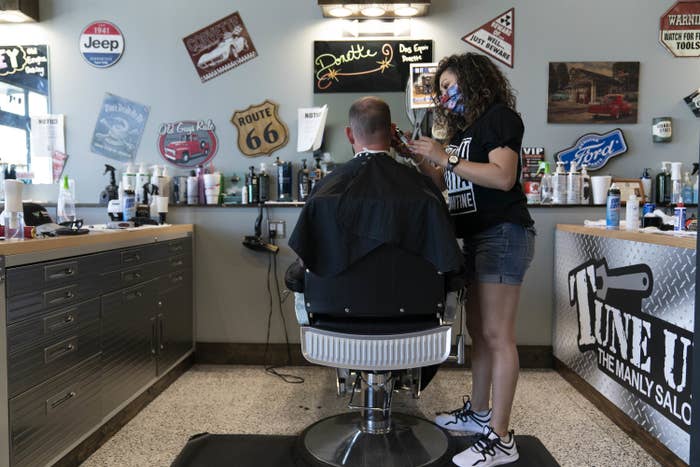
Brenda McKanna wouldn't wish the coronavirus on anyone. Right after the county clerk of Moore County, Texas, just north of Amarillo, got sick in mid-April, she said she developed a cough so deep she was throwing up blood clots and could barely move. She was unable to eat or drink for three days, and landed in the hospital with dehydration. Thirteen people in her community died from the virus, including her good friend, the county's beloved police chief Marvin Trejo. Her granddaughter also got sick, along with a few thousand other meatpacking workers in the area. For a while, Amarillo was considered the state's coronavirus ground zero and it became one of the nation's most talked-about hot spots.
Nevertheless, McKenna, a devout Christian who believes the virus is a “darkness” from the devil, was a firm believer in Texas reopening, as it began to do in April. And even as cases and hospitalizations spiked in the area in May, and hit an all-time high across the state in June, she remains a firm believer in it staying open.
“We cannot live in fear, because when we live in fear, we are being controlled,” she said. “Even if I get it a second time, I’m for our nation opening back up.”
McKanna’s reasoning might sound familiar: It’s the same refrain as hundreds of reopen protests, Facebook posts, and presidential tweets that, over the month of May, grew louder with each passing week, suggesting it was time for life to return to normal. And, in many ways, it has: — even as case numbers and hospitalizations surge in Arizona, Alaska, Alabama, and Utah, and hundreds of Americans die from the disease every day.
Despite these new spikes, leaders are grappling with how to handle the second act of a global pandemic: when residents are exhausted and antsy and terrified about the crashing economy, when patience with scientific nuance and general caution has waned, and when millions are in the streets protesting the very inequalities the virus rendered impossible to ignore.
In the Texas panhandle, this second act started ahead of the rest of America, with restaurants reopening their dining rooms, beauty salons welcoming customers, and students gathering for high school graduations against the backdrop of rising case counts. There’s a yearning for normalcy so strong that many — including some of those stricken with the virus — continue to insist that the only way forward is to learn to live with continued sickness and death.
That posture is possible, in part, because most of the cases in the panhandle have been among essential workers: in this case, clustered in the region’s meatpacking plants, whose workers are often marginalized, and who, for complex reasons, are just as desperate to downplay the virus’s effect.
As other parts of the country adjust to the current reality of reopening — figuring out what level of risk, and continued transmission, will be deemed acceptable — places like Amarillo, Texas, have already shown us a version of America’s COVID-19 future.
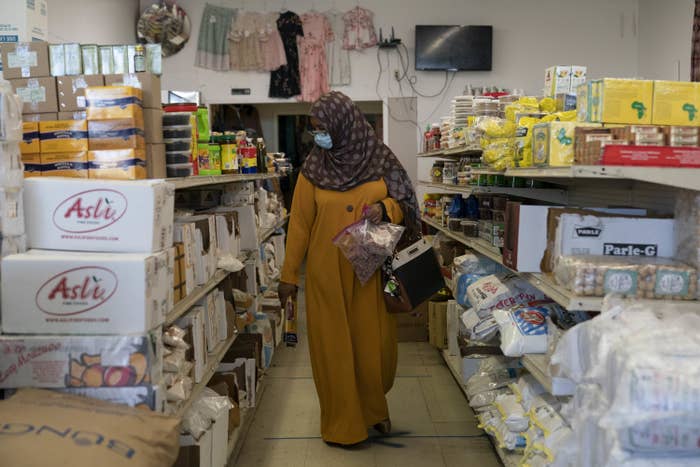
“Nobody in Amarillo lives here accidentally.” That’s how Jason Boyett, host of the popular Hey Amarillo! podcast, and a lifelong Amarillo resident, explains the area. People think of Amarillo and might think of cattle, or maybe the George Strait song. But they should also think of refugees and immigrants. “It’s much, much more diverse than a lot of people understand,” Boyett said.
The Panhandle is a rural area — and an agricultural hub — with Amarillo, a city of over 200,000, at its heart. It votes overwhelmingly for conservatives, but it also has one of the highest per capita refugee placements in the nation. It’s a place where people pay the Boy Scouts to put out flags for them five times a year, and where dozens of languages and dialects are spoken across four massive meatpacking plants. Amarillo is composed of two counties — one significantly more white (and wealthy) than the other — but it can’t be separated from the 24 other counties that make up the Panhandle, whose residents flow in and through and around the city every day.
It’s filled with the descendants of the immigrants who made a hardscrabble living on land with little water and harsh and unyielding wind, and the current wave of immigrants trying to do the 21st-century version of the same. In other words, it is a deeply American place, full of contradictions and contrasts, some stunning, some more subtle.
When thousands of refugees, largely from Myanmar and South and Central Africa, first arrived in America, they didn’t necessarily choose Amarillo. But many have chosen, in one way or another, to stay, and refugees who were originally sent to other cities have moved to join them. In 2018, Texas resettled the most refugees in America, and Amarillo welcomed the most refugees per capita in the state: nearly 7,000 between 2007 and 2017 alone.
One of the reasons refugees were placed in Amarillo was the steady demand for their labor — particularly in the meatpacking industry.
“My mom’s generation, all of them had to work at Tyson,” said Muy Aye, whose family arrived in Amarillo from Myanmar via Thailand when she was 14 years old. “They had no education, no English. “ Her family is Karen, an ethnic minority that has been persecuted in Myanmar. Aye estimates there are now around 5,000 Karen people in Amarillo, and between 80% and 90% of the adults — including many members of her family — work at Tyson’s meatpacking plant.
The reliance on refugee labor within the meatpacking industry is so strong that when Gov. Greg Abbott announced that he would no longer accept refugees in the state, the Republican mayor of Amarillo and the CEO of the Texas Cattle Feeders Association implored him to change his mind. That reliance can be traced back to 2006, when an Immigration and Customs Enforcement raid of the JBS Meatpacking Plant ended with 300 workers taken into custody. In the aftermath, the plant struggled to find employees, even after raising wages by 25%. Unlike undocumented workers, legally-resettled refugees are eligible for the same employment as American citizens. They are eager for steady work, even backbreaking work, if it provides a wage that allows them to provide for their families. And many, especially those with little English fluency, don’t have a lot of other options.

Many refugees live with their extended families, in close-knit apartment buildings and small neighborhoods. Some of those arrangements are the result of refugee service planning — it’s easier for an agency to place new arrivals, and then provide services, in one apartment complex. But part of it is natural affinity: When you’ve moved from half a world away, oftentimes after years in a refugee camp, to somewhere as alien as Amarillo, Texas, you gravitate toward the place where people celebrate the same holidays as you, pray at the same times as you, speak the same language as you, and make and sell the food you want to eat.
In Amarillo, the greatest concentration of refugee communities is in the northeast quadrant of the city, specifically in the Eastridge neighborhood. “Refugees in our community are so segregated,” Cassie Dodge, the ESL director for Catholic Charities, which oversees a significant portion of refugee placement in Amarillo, explained. “They don’t really go to the westside of town. I once tried to have my students to an activity at Target, and none of them knew where it was — it’s a 10- to 15-minute drive out of their neighborhood. I’m shocked at the division between where our refugee community lives and where white middle-class people live — I’ve never experienced anything like that.” In Atlanta, where she previously worked, it wasn’t anywhere near as divided.
Which helps explain how hundreds of people in the Amarillo area could get sick, test positive for COVID-19, and spread the disease to their families — and the rest of the city could hold to the idea that it wouldn’t come for them.

Amarillo and the surrounding area never really shut down. At least that’s how many residents describe it. Sure, some establishments closed. But it was nothing like the sweeping orders that brought cities areas across the country to a grinding halt. Gov. Abbott ordered schools and restaurants to shut their doors on March 19. But a few weeks later, he refused to call his announcement for people to avoid nonessential business a “stay-at-home order.” His ambivalence was reflected in places like Amarillo, where, on April 8, officials announced it would let “low-risk” businesses stay open, so long as they could maintain social distancing and keep fewer than 10 people in a space at a time. In practice, that meant everything from comic book stores to tanning salons opened their doors.
As hospitals were overflowing with COVID-19 patients in New York, the Amarillo area had only a handful of people testing positive for the coronavirus every day. Zack Wilson, the executive director of the High Plains Food Bank, recalled talking to other directors in Washington state and Oregon in March and April, thinking the chances of an outbreak in the area were incredibly low.
When McKanna, the county clerk, first started feeling sick on April 13, she said she’d only been going to work, the grocery store, and back home. “It was a mystery, to say the least,” she said. But three days later, Moore County reported 25 new cases of COVID-19 — putting the area, whose population is officially just under 21,000, at one of the highest per capita in the state. Area leaders instituted a curfew, but they were reluctant to take further measures, or even acknowledge the area as a hot spot. “When the government becomes too heavy-handed and tries to force people to do things, then we start taking away those liberties,” the mayor of Dumas explained. “We take away the pursuit of happiness, and to me, those are the most important things we have and supersede everything.”
On April 23, 114 workers at the JBS beef processing plant in Moore County tested positive for COVID-19. The plant is in Cactus, a wraith of a town almost entirely centered on the 125-acre Brazillian-owned plant. Workers who live in town, mostly men, pack into dilapidated apartments and mobile homes. Others take a JBS-chartered bus from Amarillo (45 minutes), carpool from Dumas (15 minutes), or make the drive from the Oklahoma panhandle (40 minutes). As in other plants that have long made Texas a center of the meatpacking industry, the pay, starting around $16 an hour, is steady. There are benefits, including healthcare. A good job can be worth a long drive.
But the structure of those “good” meatpacking jobs — the proximity of workers to each other en route and inside the plants — also puts the people who work them at high risk for a communicable disease like COVID-19. Even after JBS attempted to implement safety measures against the spread of the disease, those measures weren’t (or couldn’t be) maintained back home, on the bus, or in carpools.
Even as the local news reported on the lack of social distancing on those buses, people in the area were fatigued with the constrictions of even partial quarantine. “It’s a concern,” said Amarillo funeral director and “native son” Chad Bunt of the virus. But, he added, “let me tell you something. Everything in this town that is open is full. People are over it. They are ready to get back to the bars.”
One Amarillo woman, who asked to be identified only as Lizzie because she works for a government agency, noted that her neighbors hosted parties in their front yards “most days, and they’re definitely closer than 6 feet.”
At Lizzie’s job, which is adjacent to the healthcare industry, managers had dragged their feet to implement working from home policies until the very last minute. Her boss’s refrain: “I’ll be fine, I’m unaffected. It’s just the refugees who live together in tight quarters who are going to be sick.” Variations on that line of thinking became pervasive: I’ll be fine, I’m healthy and not over 65. I’ll be fine, I don’t live in New York. I’ll be fine, I’m not an essential worker. Or, in Amarillo, or Sioux Falls, South Dakota, or across the state of Nebraska: I’ll be fine, I’m not a refugee, and I don’t work in the meatpacking plant.
It was easy to maintain the fiction that the pandemic was other people’s problem. But during the last two weeks of April, that fiction began to slowly unravel. The virus had come. And cases were about to explode.
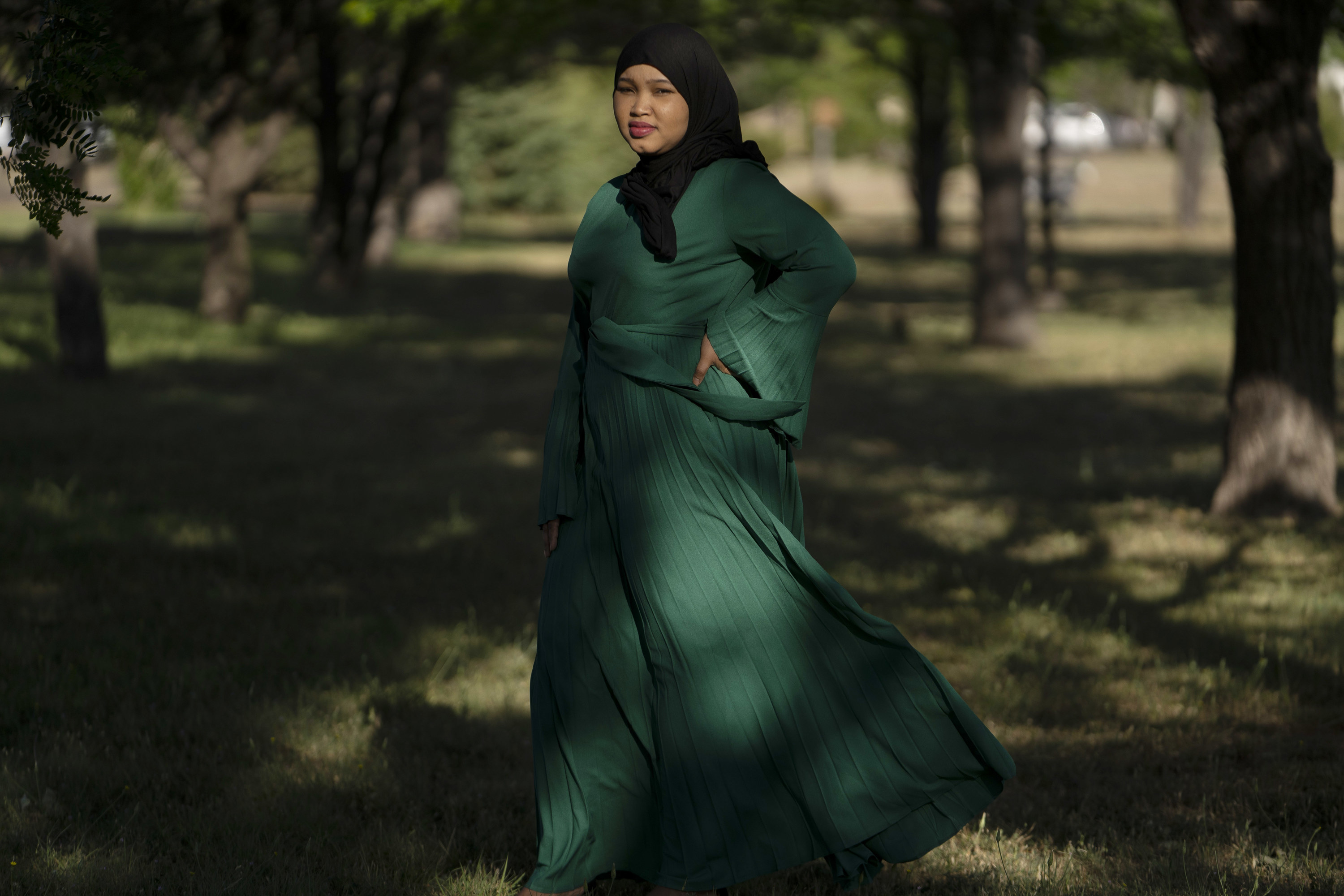
Roda Rayed is used to being tired. Originally from Somalia, the 25-year-old spent most of her life in an Ethiopian refugee camp. Five years ago, she and her family were granted asylum and placed in a bustling apartment complex in the northern part of Amarillo. With the help of one of the Somali community leaders, who connect and recruit refugees to jobs, she became a meat cutter at JBS, driving nearly an hour every day to the sprawling, stark-white plant with her brother and 67-year-old father.
It was nice working with her family, she told BuzzFeed News over video chat, but she really wanted to go back to school—she hopes to be a teacher. She eventually got a job at Tyson working the night shift, and she is now able to attend an English class run by Catholic Charities. When she gets home at about 12:30 a.m., she will either do some homework or message with some of her friends in Ethiopia before finally going to sleep. She makes about $2,000 a month, she said proudly, and gets one week of vacation. “The work is hard, so hard, I do get tired, but it’s OK,” she shrugged. It’s temporary. She plans on becoming a teacher.
Back in March, Tyson had distributed masks for workers and hung posters with reminders for hand-washing, Rayed says, with instructions written in a slew of different languages. But handwashing can only do so much when you’re shoulder to shoulder, cutting and moving and processing meat.
On April 10, after she got home from her shift, Rayed noticed that she was struggling to breathe. The large knife she wields every day to pump through pounds of beef at the Tyson plant felt heavier than normal, and she was too weak to walk and stay awake after getting home from her normal 3 p.m. to midnight shift. A few days later, she lost her sense of taste and smell.
She could barely wake up in the morning. After a few days, she was so fatigued she had to call out of work. After spending a few days reading about COVID-19 on social media, she realized she had it. She sequestered herself in her room for two weeks, with her mom leaving food outside her door. On April 24, Tyson management told her that she would need to be tested for COVID-19 in order to approve her for leave, so she made her way to the hospital.
That day, the number of cases in Amarillo and Moore County leaped to 608. In a press conference that same day, Amarillo Mayor Ginger Nelson continued to discuss plans for the city’s gradual reopening, referring to the recent rise in cases as a “surge” — and declined, even when asked, to specify the location the hot spot.
But a week later, the disease’s spread had become too much for Amarillo-area health officials to handle on their own. On Facebook, Mayor Nelson announced that the CDC would be arriving to organize testing and mitigation efforts at both JBS, in Moore County, and at the Tyson meatpacking plant just outside of Amarillo.
But if you wait until a massive spike in cases to identify and attempt to mitigate an outbreak, public officials will tell you, you’re usually too late. The disease is already everywhere.

The fact that Rayed eventually realized that she probably had COVID-19 because of social media — and not from Tyson, or the health department — underscores the difficulty in protecting these workers from a highly contagious disease. According to one of the plant’s chaplains, Tyson usually disseminates information to various groups with limited English proficiency by meeting with leaders in and outside of the factory, who then communicate the information to the rest of the group.
But something broke down in the process. Multiple workers from various refugee groups said that they had received little to no communication about the disease in their native language in March and April. The “report card” with case counts, issued by the health department, was initially only in English. They eventually added Spanish, but no other languages. Dodge, the director of ESL services, never received information to distribute to her students. And the health department had no one translating in languages other than Spanish until mid-May, when the CDC hired nine additional translators from the refugee community.
One of those translators was Salad Dualle. Back on April 27, Ryan Pennington, the head of the Amarillo Refugee Language Project, invited Dualle over to his house for a socially distanced “porch talk.” Back in Somalia and Kenya, Dualle had trained to become a physician. In Amarillo, where he’s lived since 2009, he provides medical translation services and owns a small trucking company.
When Dualle showed up at Pennington’s porch, he was scared. His community was already sick. Many, like Rayed, had heard about COVID-19, but according to Dualle, only 50% of the Somali community in Amarillo can read or write the Somali language. Eighty percent of the community does not speak English with any sort of fluency. Dualle had helped put together flyers to post in the halal grocery and the mosque before it shut down, but the problem wasn’t just alerting people to the disease. It was getting them to admit that they might have it — and then isolate accordingly.
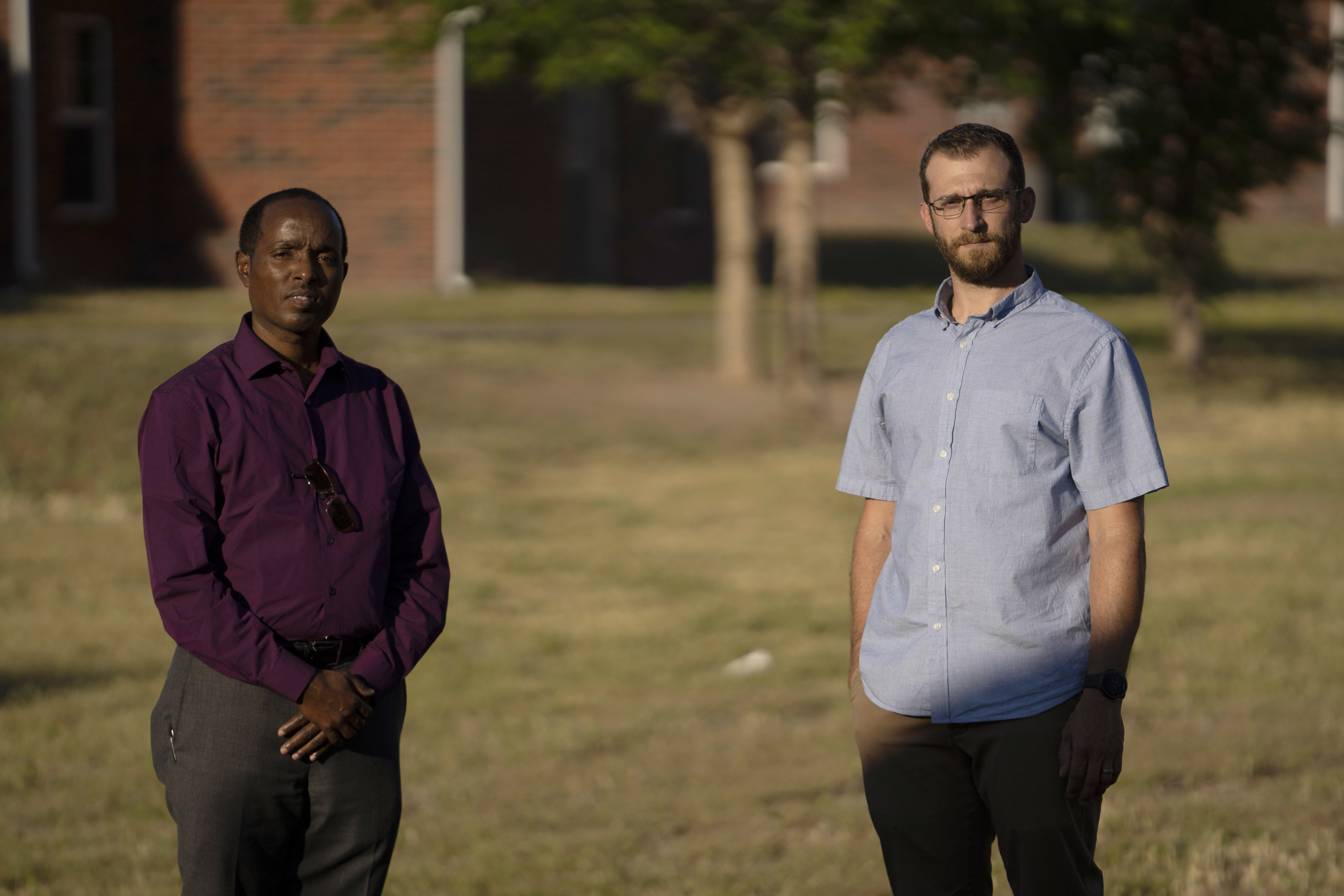
In mid-May, Dualle estimated that around 200 Somalis in the Amarillo area had received positive test results. “But we cannot have the real figure of COVID-positive numbers,” he said, “due to the stigma.” One woman in the community, he said, had tested positive, but assured others she had tested negative. Many Somali adults have sharp memories of the HIV/AIDS pandemic in Africa — and assume that COVID, like HIV, will be with them for the rest of their lives.
“When someone is HIV-positive in Africa, they are isolated. They are not allowed near. They cannot drink or eat near other people. They are considered morally low,” Dualle said. “I try to explain to people who have tested positive that you are an ordinary person — that COVID-19 can be positive in rich people, in higher people, even for the prime minister of the UK! Don’t make it like this!”
There’s also a fear, Pennington explained — among the Somali, but also among other refugees who’ve fled incredibly repressive and violent political regimes — that getting sick could get them deported or killed. And then there’s the general anxiety about losing their jobs. When Dualle helps translate for Somali people who have tested positive for the coronavirus, many are frustrated that they can’t go back to work, whether because, like hundreds from the Tyson plant, they’re asymptomatic, or because they’re living with someone who had tested positive. “They say to me, the income from Tyson is the only income that’s paying the utility bill,” Dualle explained. “They say, if I isolate, who’s going to pay me?”
Dualle tried to tell people to communicate with their employers to figure out how to get paid. Tyson, for example, is arranging for workers to get paid through short-term disability if they have to stay home. But the process is complicated, and requires fluency in English. Sam Isra arrived in Amarillo from Laos in 1984. The next year, his wife got a job at Tyson, where she has worked ever since. She has had no symptoms of COVID-19, but tested positive and has been home in isolation. Isra said he’s had to get on the phone five times with various agencies, because Tyson’s insurance continued to file his wife’s absence as Family and Medical Leave Act — a labor law that would protect her job and health insurance — but without pay.
Some workers have their English-speaking children do that work for them. But some have no one at all, and most people would rather just go back to work. Rayed said that one of her friends, a 26-year-old single mom from Somalia who’s raising two kids, simply hid her symptoms.
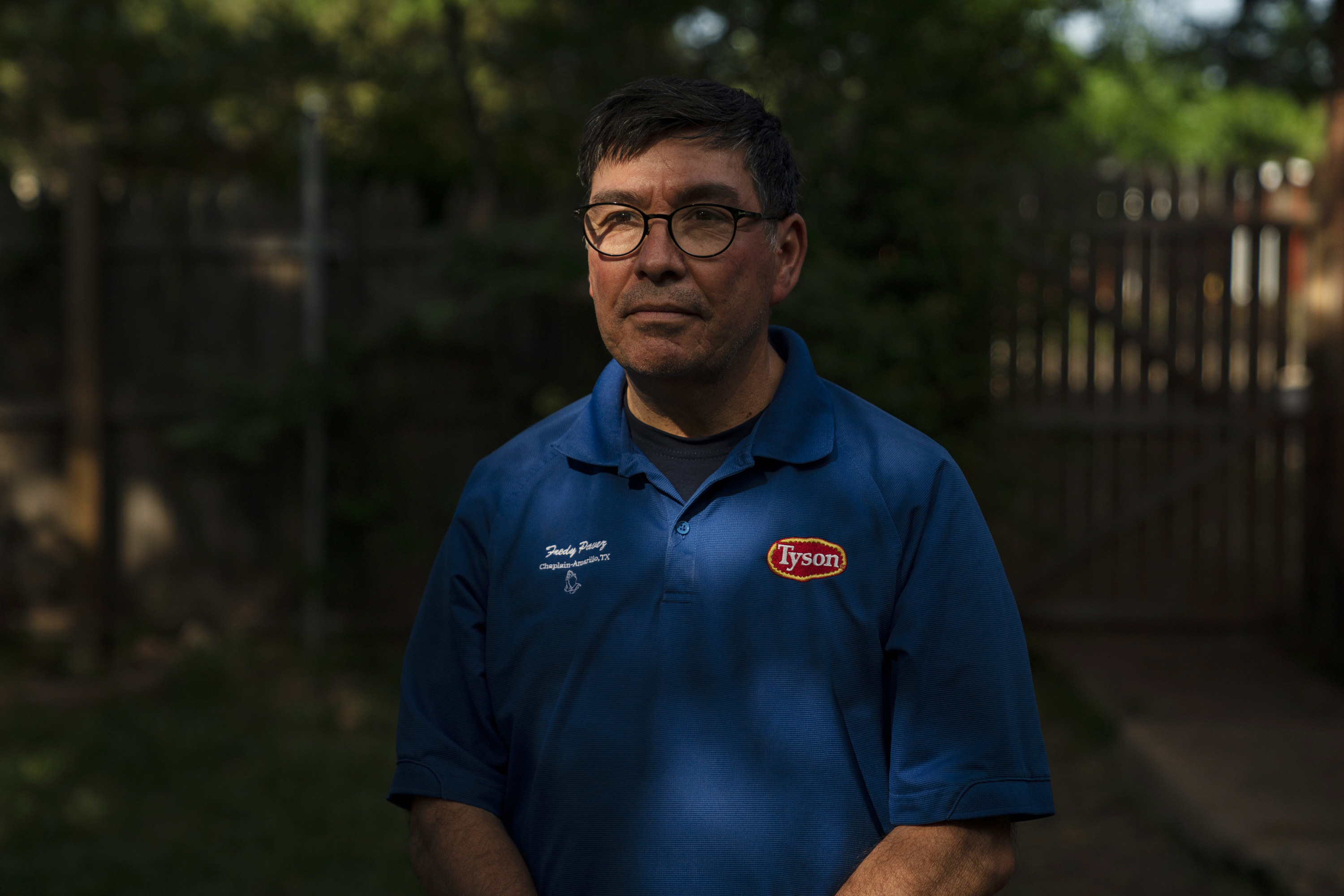
Fredy Pavez, 59, is one of two chaplains at Tyson, where his job is to provide support and counsel for the plant’s nearly 5,000 workers who speak more than 40 languages and 100 dialects.
The pastors of various refugee churches have told Pavez that members of their community have been turned away at stores, simply because they were wearing their Tyson jackets. “There’s a big movement against those who work in the plants,” Pavez said. “They think we are ones who are bringing it. But we are mandatory workers.”
Lately, Pavez has been going nonstop. His role now is to help the hundreds of workers who have COVID-19, making sure those who are quarantined have enough food and understand the precautions they need to take to avoid infecting their family. It’s been tough, trying to calm crying, terrified Tyson employees standing in line at the National Guard’s white tents for nasal swabs.
“Some of those people are 65, 70, 75 years old. They are very scared. They did not want to get tested. They think they are going to have surgery,” he said. “Some of them have no family around. [The chaplains] don’t understand the language so I show them a thumbs-up.”
After work, he leaves the plant and drives 20 minutes home to the small, rugged town of Panhandle, where his neighbors have decided that the virus won’t really affect them.
“No one wears masks in this town,” he said, chuckling.
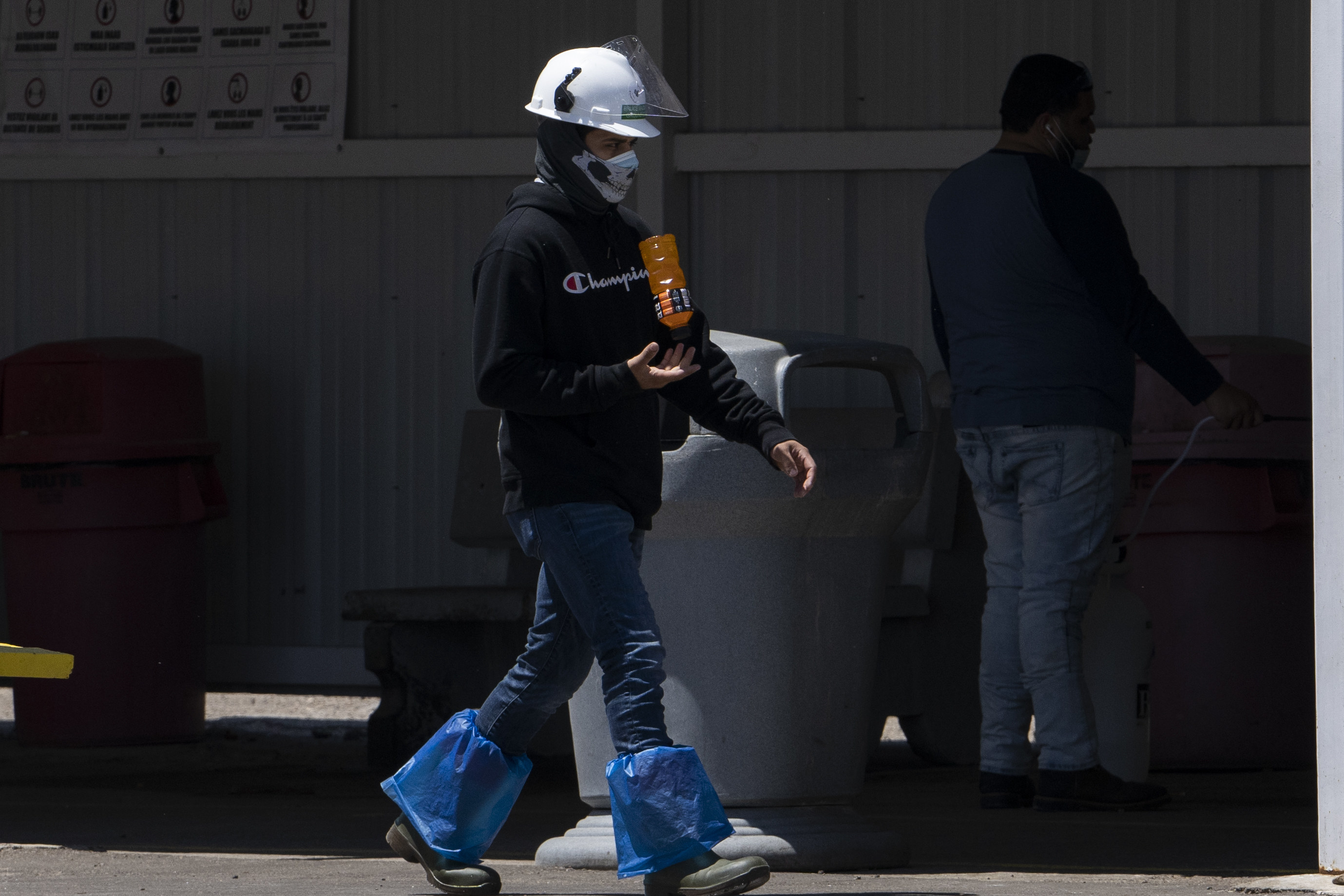
“I’ve been annoyed and frustrated with how a lot of residents have treated the outbreak,” Jason Boyett, the Hey Amarillo! host, said back in May. “And the way that partisanship has played out in this moment, when wearing a mask seems to indicate your political affiliation.”
But like others, he also sees the casual attitude as an extension of the clustering of the refugees, and their natural reliance on leaders in their own communities.
“We’re in a situation where a person in Amarillo might be very friendly and welcoming to a refugee, but they just don’t know that many,” Boyett said. If you found yourself on Amarillo Boulevard on the west side of town, near the Amarillo Country Club, you can drive east, across Washington Street, into the area where most refugees live, and feel like you’re in a different town entirely. As one woman put it, “you only go to northeast Amarillo if you are visiting someone who lives there or want some authentic Mexican food.”
“We have a tendency to live in our bubbles,” Boyett said. “And that reflects in our current attitudes, when we see an enormous increase in cases, which should be terrifying — until they find out that it’s spreading within a community of immigrants, or meatpacking employees, and you can say, That’s not my community. I don’t have interaction with that community, therefore I’m safe. It’s an othering of the problem.”
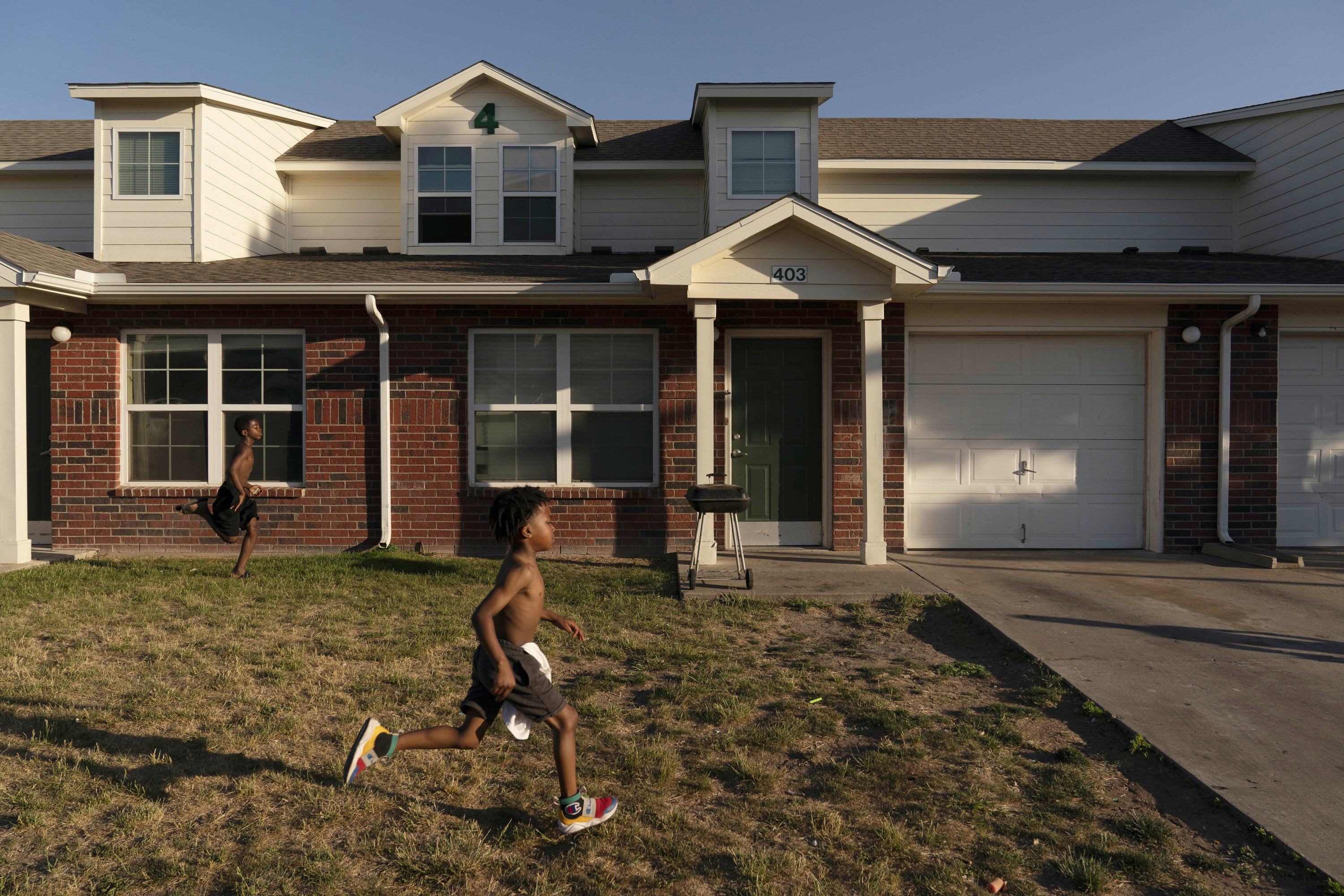
That sort of psychological distancing is also common among Amarillo residents, who think of places like Dallas, or Austin — which is eight hours away, and known as a liberal oasis — as almost another state. “So we get that it’s another neighborhood, it’s not my problem on the local level,” Boyett explained, “but also on the state level, and even on the national level.”
On May 6, as COVID-19 continued to spread at Tyson, workers ended their shifts, walked out of the building, and were handed T-shirts. “My Work Feeds the Nation,” the shirts read, with a fork emblazoned with the Stars and Stripes beside it.
During the pandemic, the slogan has become pervasive — propagated in corporate messaging and trickling down to Facebook profile pic filters. If you go on the interstate, you’ll likely pass a rig hauling live cows or cow parts. If you drive 10 minutes outside of Amarillo, in pretty much any direction, you’ll pass a feedlot. You’ll smell the feedlot. “Everybody in Amarillo knows about the cattle industry and the importance that it plays,” Boyett explained. “And when the wind is blowing a certain way, it blows the smell of the feedlot into town.”
When Tyson was handing out shirts in early May, they had yet to publicly confirm a single case at the plant, even though dozens of workers, like Rona Rayed, had been out sick for weeks. Two days later, Pwar Gay, a Karen woman who’d worked at Tyson for eights years, died of complications of COVID-19. Her husband and several of her adult children still work at the plant.
Gay’s family’s lawyer, Vuk Vujasinovic, says that despite Tyson’s messaging to the contrary, Gay wasn’t given personal protective equipment. In a statement, Tyson officials said: “We are saddened by the loss of any Tyson team member and sympathize with Ms. Gay’s family at this difficult time. At Tyson Foods, our top priority is the health and safety of our team members, and we have put in place a host of protective steps at our facilities that meet or exceed CDC and OSHA guidelines for preventing COVID-19.”
Gay’s daughter declined to speak about her mother’s death. “It hurts too bad,” she said. She had to get back to running her nail salon. It was very busy. Like Governor Abbott said, it’s time to move on and get back to work. ●

